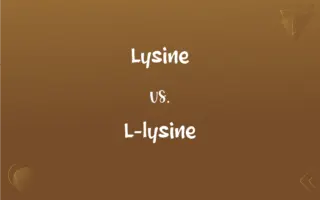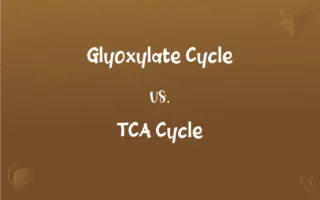Polymer vs. Biopolymer: What's the Difference?
Edited by Aimie Carlson || By Janet White || Published on February 22, 2024
A polymer is a large molecule made of repeating subunits, while a biopolymer is a type of polymer naturally produced by living organisms.

Key Differences
Polymers are large molecules composed of repeating structural units, typically connected by covalent chemical bonds. These are synthetic or natural in origin, like plastics, resins, and fibers. Biopolymers, a subset of polymers, are naturally occurring polymers produced by living organisms. Examples include proteins, nucleic acids, and polysaccharides.
The source of polymers can be both natural, like cellulose in plants, or synthetic, like polystyrene. Their properties and uses are diverse, spanning from industrial materials to everyday products. Biopolymers are always derived from biological sources and play crucial roles in the structure and function of living cells. They are key in biological processes and are biodegradable.
In terms of environmental impact, many synthetic polymers, particularly plastics, pose significant environmental challenges due to their non-biodegradable nature. Biopolymers, on the other hand, are typically biodegradable and environmentally friendly, decomposing naturally and reducing pollution.
Polymers can be engineered for specific traits like strength, flexibility, or resistance to heat and chemicals, making them versatile for various applications. Biopolymers, while also versatile, are often used in fields like medicine and agriculture due to their biocompatibility and natural origin.
The production of polymers often involves chemical processes and polymerization of monomers, which can be energy-intensive. The synthesis of biopolymers occurs naturally in living organisms and is part of biological processes like metabolism and cellular function.
ADVERTISEMENT
Comparison Chart
Source
Natural or synthetic
Biological, from living organisms
Examples
Plastics, nylon, PVC
DNA, proteins, cellulose
Biodegradability
Varies, often non-biodegradable
Typically biodegradable
Uses
Broad, including industrial uses
Medicine, biotechnology, sustainable materials
Environmental Impact
Can be pollutive
Generally eco-friendly
ADVERTISEMENT
Polymer and Biopolymer Definitions
Polymer
A polymer is a substance composed of large molecules with repeating units.
Nylon, a synthetic polymer, is used extensively in clothing.
Biopolymer
Biopolymers include natural polymers like proteins and carbohydrates.
Collagen, a protein biopolymer, is vital for skin elasticity.
Polymer
Polymers are large molecules with diverse properties and applications.
Silicone polymers are used in medical devices and cookware.
Biopolymer
Biopolymers are naturally occurring and often biodegradable.
Cellulose, a biopolymer, is used in making eco-friendly packaging.
Polymer
Polymers are macromolecules formed by polymerizing monomers.
Polyethylene is a common polymer in plastic bags.
Biopolymer
Biopolymers are polymers produced by living organisms.
DNA, a biopolymer, carries genetic information.
Polymer
Polymer refers to a large molecule made from many similar smaller molecules.
The rubber in tires is a form of polymer.
Biopolymer
Biopolymers play critical roles in the structure and function of cells.
Starch, a biopolymer, is a storage form of energy in plants.
Polymer
Polymers can be natural or synthetic, comprising long chains of repeating units.
Cellulose, a natural polymer, is found in plant cell walls.
Biopolymer
Biopolymers are essential in biological processes and sustainable technologies.
Chitin, a biopolymer, is being explored for biodegradable plastics.
Polymer
Any of numerous natural and synthetic compounds of usually high molecular weight consisting of up to millions of repeated linked units, each a relatively light and simple molecule.
Biopolymer
A macromolecule in a living organism that is formed by linking together several smaller molecules, as a protein from amino acids or DNA from nucleotides.
Polymer
(organic chemistry) A long or larger molecule consisting of a chain or network of many repeating units, formed by chemically bonding together many identical or similar small molecules called monomers. A polymer is formed by polymerization, the joining of many monomer molecules.
Biopolymer
(biochemistry) Any macromolecule of a living organism that is formed from the polymerization of smaller entities; a polymer that occurs in a living organism or results from life.
Polymer
A material consisting of such polymer molecules.
Polymer
Any one of two or more substances related to each other by polymerism; specifically, a substance produced from another substance by chemical polymerization.
Polymer
A naturally occurring or synthetic compound consisting of large molecules made up of a linked series of repeated simple monomers
FAQs
What is a polymer?
A polymer is a large molecule composed of repeating subunits.
Is DNA a biopolymer?
Yes, DNA is a natural biopolymer.
Are all polymers synthetic?
No, polymers can be both synthetic and natural.
How are synthetic polymers made?
Synthetic polymers are made by polymerizing monomers in chemical processes.
Can polymers be biodegradable?
Some polymers, especially biopolymers, are biodegradable.
Are biopolymers environmentally friendly?
Yes, most biopolymers are eco-friendly and biodegradable.
What are examples of synthetic polymers?
Examples include plastics like polyethylene and polystyrene.
Do biopolymers have medical applications?
Yes, biopolymers are used in drug delivery systems and tissue engineering.
What are biopolymers?
Biopolymers are polymers naturally produced by living organisms.
What is the main use of biopolymers?
Biopolymers are used in medicine, biotechnology, and sustainable materials.
What is the difference in source between polymers and biopolymers?
Polymers can be from natural or synthetic sources, while biopolymers always come from biological sources.
Is rubber a polymer?
Yes, natural rubber is a polymer, and synthetic rubbers are also polymers.
Are biopolymers used in food packaging?
Yes, biopolymers like PLA are used in eco-friendly food packaging.
Can biopolymers replace synthetic polymers?
In some applications, biopolymers are being developed as alternatives to synthetic polymers.
Can polymers conduct electricity?
Some specialized polymers, called conducting polymers, can conduct electricity.
Are proteins and carbohydrates biopolymers?
Yes, they are natural biopolymers.
Are all biopolymers biodegradable?
Most biopolymers are biodegradable, but their degradation rates can vary.
What role do biopolymers play in nature?
Biopolymers are essential in biological structures and processes.
How do biopolymers impact sustainability?
Biopolymers contribute to sustainability due to their biodegradability and renewable sources.
Can polymers be recycled?
Some polymers, particularly certain plastics, can be recycled.
About Author
Written by
Janet WhiteJanet White has been an esteemed writer and blogger for Difference Wiki. Holding a Master's degree in Science and Medical Journalism from the prestigious Boston University, she has consistently demonstrated her expertise and passion for her field. When she's not immersed in her work, Janet relishes her time exercising, delving into a good book, and cherishing moments with friends and family.
Edited by
Aimie CarlsonAimie Carlson, holding a master's degree in English literature, is a fervent English language enthusiast. She lends her writing talents to Difference Wiki, a prominent website that specializes in comparisons, offering readers insightful analyses that both captivate and inform.




































































